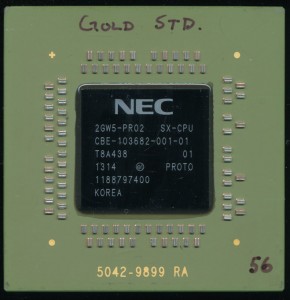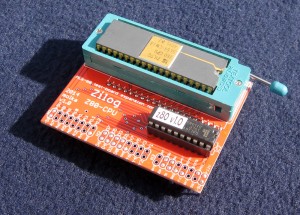February 22nd, 2015 ~ by admin

NEC SX-ACE Processor Prototype – 2013
When Vector computing is mentioned, the first company that comes to mind is Cray. Cray was the leading designer and builder of vector supercomputers since the 1970’s. Vector computing is a bit different then general purpose computing. Simply put, a vector computer is designed to perform an instruction on a large set of data at the same time. Such vector support has been added to x86 (in the form of SSE) as well as the PowerPC architecture (AltiVec) but they were not originally designed as such. Cray however, is not the only such company. In 1983 NEC announced the SX architecture. The SX-1/2 operated at up to 1.3 GFLOPs and supported 256MB of RAM per processor. By 2001 with the SX-5 and SX-6 performance had increased to 8 GFLOPS and supported 8GB of RAM per CPU. For a short while Cray themselves marketed and sold NEC SX computers. Each of the processors, from SX-1 to the SX-9 was a single core processor, but with the SX-ACE, that changed.
Read More »
February 15th, 2015 ~ by admin

Z80 Expansion Board
Now available at The CPU Shack are the Z80 and i8085 Expansion boards for the MCS-80 test boards. The i8085 and Z80 expansion tools allow the MCS-80 test-board to test the function of Intel 8085 (and compatible) or Z80 (and compatible) CPUs. The test tools are connected via the ZIF socket for the i8080 CPU and into the 3×16 pin header connectors of the MCS-80 test-board. There is no need to modify or replace anything on MCS-80 test-board.
This is possible because both the Z80 and i8085 CPUs are based on the Intel 8080 processor. The 8085 is nearly the same as the 8080 from a software point of view, Intel just greatly simplified the hardware required to support it.
They are currently available for $29.95 each shipped.
February 13th, 2015 ~ by admin

TI RAY9000C-X – SBR9000 Radiation Tolerant Processor
In the previous post the TI TMS/SBP9900 was covered, as well as its successor the SBP9989. The 9989 was to be replaced by the 9989E, a 50% shrink to 2.2u. This was never released, but TI did continue to develop the bipolar line of the 9900s. After canceling (or perhaps just renaming?) the 9989E/9990 TI announced the SBR9000 in 1985. The SBR9000 was a hi-speed 9989 successor fab’d on a 2 micron I2L process and clocked at 9MHz (twice the speed of the 9989). The change in prefix from SBP to SBR hints at another feature, while the SBP9989 was a MIL-STD-883 rated part, the SBR9000 (and its peripherals) were designed for very high radiation tolerance. The SBR9000 was spec’d to have a total dose tolerance of 1 MegaRad (it should be noted that around 10 krads proves fatal to the average person).
The part number of this example, RAY9000C-X is a bit mysterious but there are some strong clues as to its being a prototype of the canceled SBR9000. First of course is the 64-pin CDIP package, conveniently having 4 ground pins marked. Pins 1,2,27 and 28 are the ground pins on all SBP9900/9989 devices. The SBR was to be pin compatible so has the same ground pins. The date on the back of the RAY9000 is 8525, the SBP9900 was out of production in 1983 so that rules it out, leaving either a 9989, or the most likely, a sample of a SBR9000. Why TI canceled the SBR9000 remains a mystery, perhaps they found the 9989 to be adequate for their customers needs, as it continued to be produced into the 1990’s.
February 5th, 2015 ~ by admin

TI TMS9900JL – 1978
In June 1976 TI released the TMS9900 16-bit processor. This was one of the very first 16-bit single chip processor designs, though it took a while to catch on. This is no fault of its own, but rather TI’s failure to market it as such. The 9900 is a single chip implementation of the TI 990 series mini-computers. It was meant to be a low end product and thus was not particularly well supported by TI, who did not want to cut into the higher margins of their mini-computer line. By the late 1970’s TI began to see the possibilities of the 9900 as a general purpose processor and began supporting it with development systems, support chips, and better documentation. If TI had marketed and supported the 9900 from its release the microprocessor market very much may have turned out a bit different. A large portion of Intel’s success (with the 808x) was not due to a good design, but rather good support and availability.
The original TMS9900 was a 3100 gate (approx 8000 transistors) NMOS design running at up to 3MHz. It required a 4-phase clock and 3 power supplies (5V, 12V, -5V). It had a very orthogonal instruction set that was very memory focused, making it rather easy to program. General purpose registers were stored off chip, with only a PC, Workspace Register (which pointed to wherever the general registers would be) and a Status Register on chip. This made context switching fairly quick and easy. A context switch required saving only 2-3 registers. The 9900 was packaged in a, then uncommon, and expensive, 64 pin DIP. This allowed the full 15-bits of address and 16-bits of data bus to be available.
TI had a trick up their sleeve for the 9900 line…
Read More »





